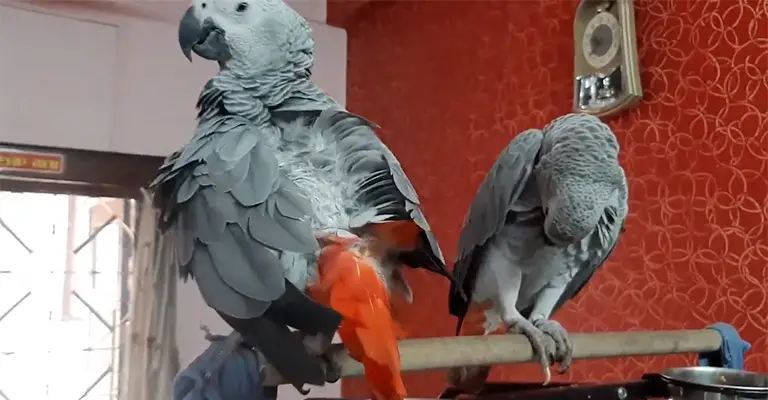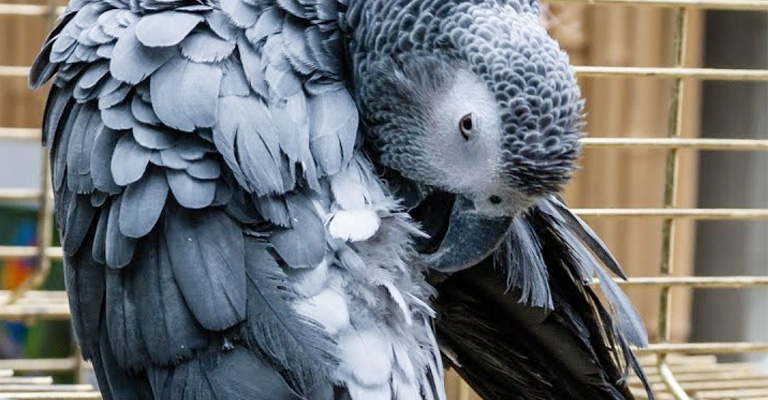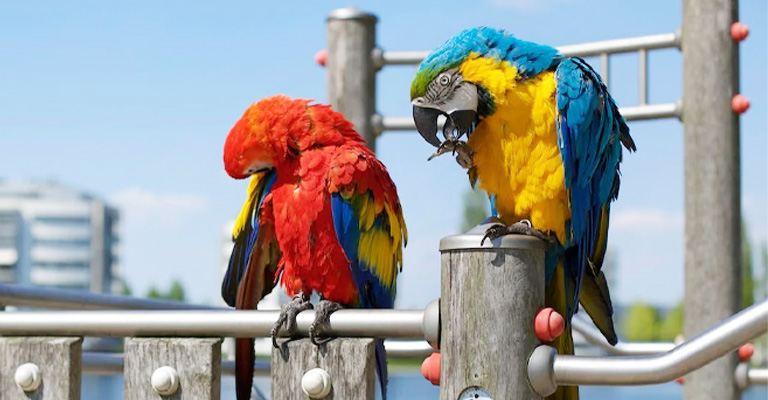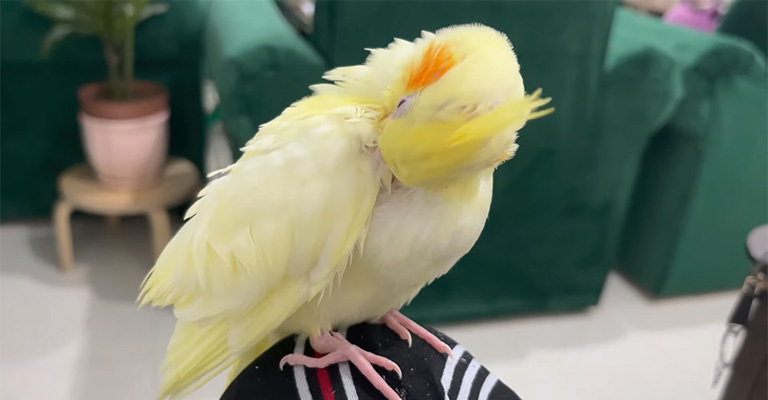Birds are amazing creatures that have fascinated humans for centuries. They can fly, sing, migrate, and display various colours and patterns. But one of the most common and essential behaviours that birds engage in is preening their feathers.
Preening is the regular, essential grooming practised by birds to keep their feathers clean, healthy, and strong. Birds’ feathers need to be in top condition for efficient flight and to ensure they can regulate their body temperatures and keep dry in wet weather. Healthy feathers are the key to a bird’s survival, necessary for flight, warmth, waterproofing and thermoregulation.
This article will explore why birds preen their feathers, how they do it, and what benefits they get from it. We will also answer some frequently asked questions about bird preening.

What Is Preening for Birds?
Preening uses the beak and sometimes the feet to arrange, clean, and condition the feathers. Birds preen their feathers to remove dust, dirt, parasites, and debris from their plumage.
They also apply a waxy substance called preen oil to their feathers to protect them from water and damage. Preening also helps to align the feathers into the optimal position for flight and insulation.
Preening is not only a physical activity but also a psychological one. Preening makes the bird feel good, as it can stimulate the production of endorphins, which are natural painkillers. Preening also helps to reduce stress and boredom, as well as to communicate with other birds.
How Do Birds Preen Their Feathers?

Birds use different methods and tools to preen their feathers. Here are some of the most common ones:
The Beak
The brim is birds’ primary tool to preen their feathers. They use it to nibble, stroke, comb, and fluff each feather from its base to its tip. They also use it to remove any feather sheaths that cover new feathers after moulting.
The Uropygial Gland
The uropygial gland, also known as the preen gland, is a particular organ located near the base of the tail of most bird species.
It produces a waxy substance called preen oil that birds apply to their feathers with their beaks. Preen oil helps to waterproof and condition the feathers, making them more flexible and resistant to wear and tear.
The Feet
Some birds use their feet to preen hard-to-reach areas of their body, such as the head and neck. They scratch or rub their feathers with claws or toes to remove dirt or parasites.
The Tongue

Some birds have a specialised language that can help them preen their feathers. For example, hummingbirds have long tongues that can reach into their nostrils and clean them. Parrots have a tongue that can split into two parts and act like a comb or a brush.
Dust baths
Some birds take dust baths to absorb excess oil or moisture from their feathers. They roll or rub themselves in dry soil or sand to coat their plumage with fine particles that soak up unwanted substances. Then they shake off the dust and preen usually.
Water Baths
Some birds take water baths to wash off dirt or parasites from their feathers. They splash or dip themselves in fresh or saltwater sources, such as ponds, streams, oceans, or raindrops. Then they dry off by shaking or sunning themselves and preen normally.
Anting
Some birds practice anting, which is the behaviour of rubbing ants or other insects on their feathers. Anting may help to remove parasites or fungi from the plumage or to apply formic acid or other chemicals that act as insecticides or fungicides.
Allopreening
Some birds engage in allopreening, which is mutual preening between two or more individuals. Allopreening may help to reach areas that are difficult to preen by oneself, such as the head or neck. Allopreening also serves a social function, strengthening bonds between mates, family, or flock members.
Why Do Birds Preen Their Feathers?

Birds preen their feathers for several fundamental reasons for their survival and well-being. Here are some of the main benefits of preening:
Flight
Preening helps to keep the feathers in the best shape for flying. By aligning the feathers into the most aerodynamic position, preening reduces drag.
It increases lift, making the flight more accessible and more efficient. Preening also helps repair damaged or broken feathers that may impair flight performance.
Waterproofing
Preening helps keep the feathers waterproof, essential for birds that live in wet environments or dive into the water to hunt or feed.
By applying preen oil or powder down to the feathers, preening creates a barrier that prevents water from penetrating the plumage and reaching the skin. Waterproofing also helps prevent feather rot or mould, which can harm the bird’s health.
Insulation
Preening helps to keep the feathers insulated, which is essential for birds that live in cold or hot climates. By fluffing up or smoothing down the feathers, preening adjusts the amount of air trapped between the plumage and the skin, which acts as a layer of insulation. Insulation helps regulate the bird’s body temperature and prevent heat loss or gain.
Parasite Control
Preening helps to keep the feathers free from parasites, such as lice, mites, fleas, or ticks, that can damage the plumage or transmit diseases.
By removing any parasites or their eggs from the feathers, preening reduces the risk of infection and irritation. Preening also helps to remove any debris or foreign objects that may harbour parasites or bacteria.
Moulting
Preening helps to facilitate moulting, which is the process of shedding old feathers and growing new ones. By removing any feather sheaths that cover new feathers after moulting, preening helps to get them into the proper position more quickly so they can be helpful right away. Preening also helps dispose of old feathers that may fall off during moulting.
Appearance
Preening helps improve the bird’s appearance, which is essential for attracting a mate or signalling status. By cleaning and arranging the feathers into a neat and colourful display, preening enhances the attractiveness and healthiness of the bird. Preening also helps to express emotions or intentions, such as aggression, submission, curiosity, or affection.
FAQs
No, not all birds tend. Some birds lack a uropygial gland or powder down feathers and rely on other methods to keep their plumage in good condition. For example, owls have specialised feathers that break down into powder down, which they spread with their beaks. Penguins have a gland that produces oil that they apply with their flippers. Emus have double-shafted feathers that do not need preening.
Birds groom several times daily, depending on their species, habitat, diet, activity level, and social context. Some birds tend more frequently than others, such as parrots and macaws. Some birds preen more during certain seasons or times of day, such as before dawn or after dusk. Some birds, such as captive or pet birds, tend more when stressed or bored.
Birds tend to each other for various reasons, such as grooming, bonding, courtship, communication, or cooperation. Allopreening is a form of mutual preening between two or more individuals. Allopreening may help to reach areas that are difficult to preen by oneself, such as the head or neck. Allopreening also serves a social function, strengthening bonds between mates, family, or flock members.
Many birds, especially those that live in pairs or groups, tend to one another. Some examples of birds that practice allopreening are parrots, cockatoos, lovebirds, budgies, finches, pigeons, doves, crows, ravens, starlings, sparrows, swans, geese, ducks, flamingos, pelicans and albatrosses.
You can help your pet bird preen by providing it with a clean and comfortable environment, a balanced and varied diet, fresh water for drinking and bathing, toys and enrichment items for stimulation and entertainment, and regular attention and interaction. You can gently stroke or scratch your bird’s feathers with your fingers or a soft brush, but be careful not to overdo it or damage the plumage.
Conclusion
Preening is an essential behaviour to keep their feathers in good condition. Preening benefits birds’ flight efficiency, thermoregulation, hygiene, and mood.
Preening involves using the beak, the uropygial gland, the feet, the tongue, and other methods and tools to clean, condition, and arrange the feathers.
Preening can also be a social behaviour that strengthens bonds and signals trust and affection between birds.
We can appreciate their beauty and intelligence more by understanding why birds preen their feathers. We can also help our pet birds tend their feathers by providing them with a suitable environment and care.